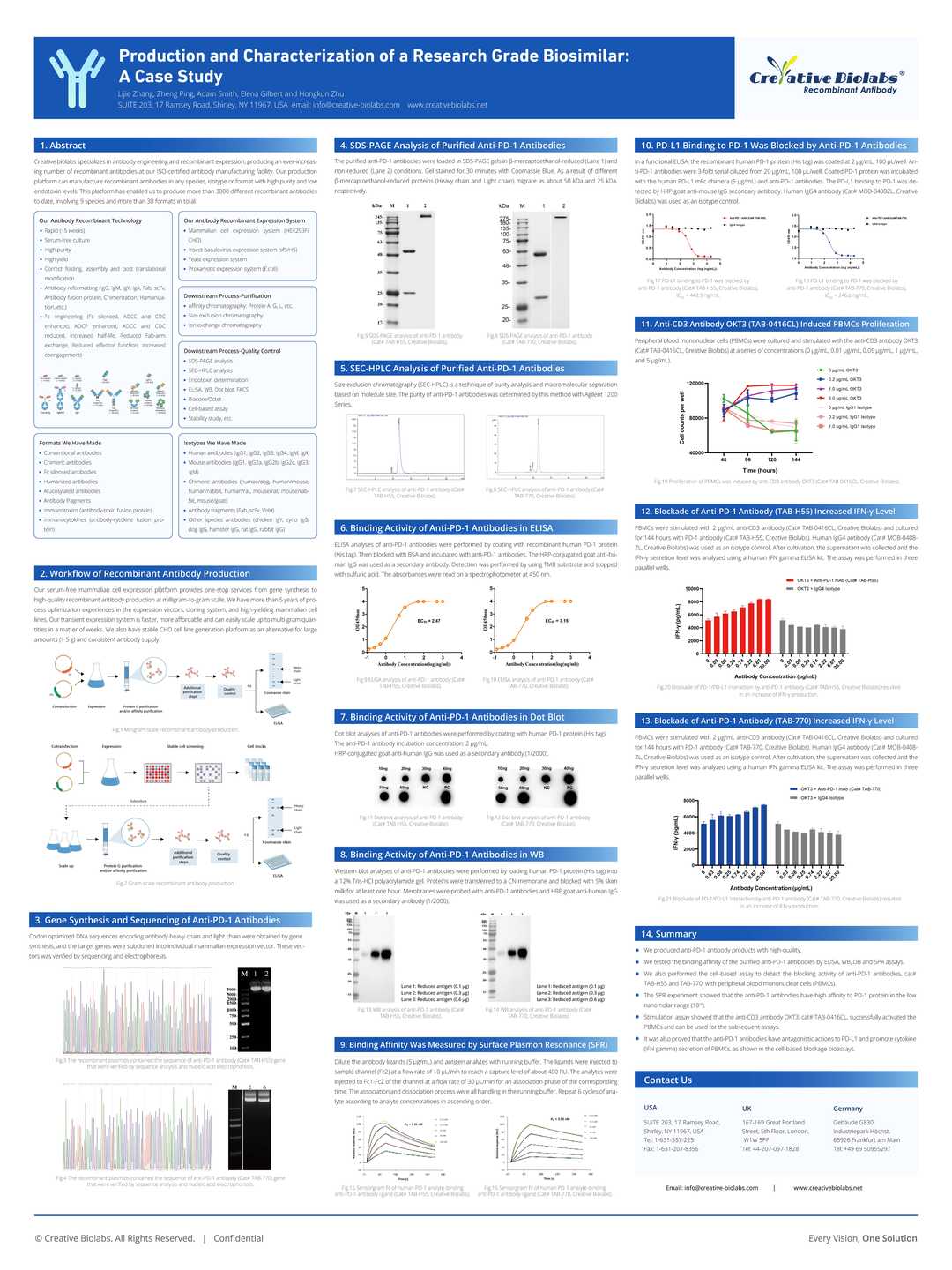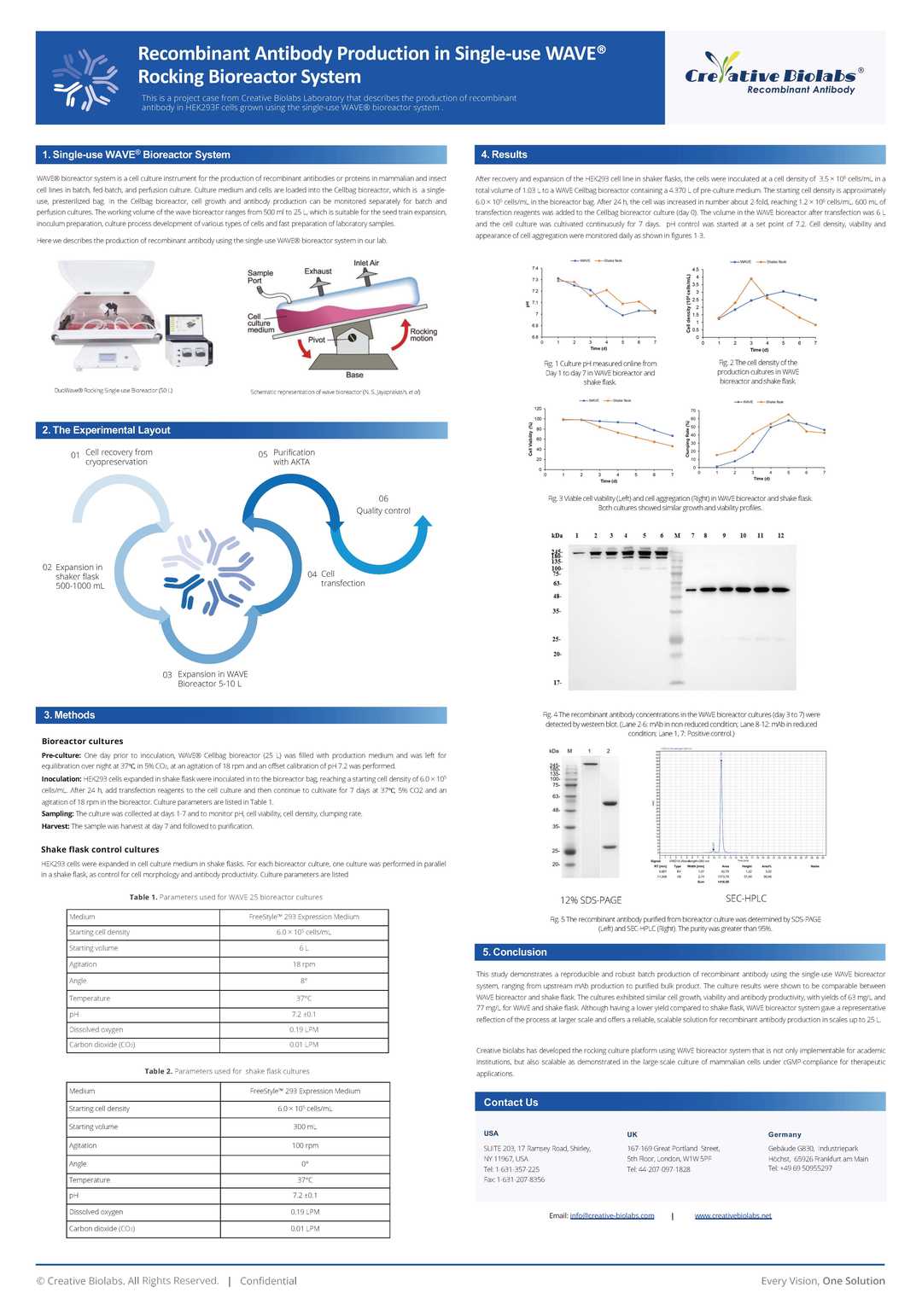Rabbit Anti-HMGB1 Recombinant Antibody (VS3-CJ537)
CAT#: VS3-CJ537
This product is a rabbit antibody that recognizes human, mouse, and rat HMGB1.












Specifications
- Immunogen
- Recombinant protein
- Host Species
- Rabbit
- Type
- Rabbit IgG
- Specificity
- Human, Mouse, Rat HMGB1
- Species Reactivity
- Human, Mouse, Rat
- Applications
- WB, ICC, IF, IHC, FC
- Conjugate
- Unconjugated
Product Property
- Purification
- Protein A affinity purified
- Purity
- >95% as determined by SDS-PAGE
- Format
- Liquid
- Buffer
- 40% Glycerol, 1% BSA, TBS, pH7.4.
- Preservative
- 0.05% Sodium Azide
- Storage
- Store at 4°C for short term. Aliquot and store at -20°C for long term. Avoid repeated freeze/thaw cycles.
Applications
- Application Notes
- This antibody has been tested for use in Western Blot, Immunocytochemistry, Immunofluorescence, Immunohistochemistry, Flow Cytometry.
Target
- Alternative Names
- HMG1; HMG3; HMG-1; SBP-1
- Gene ID
- 3146
- UniProt ID
- P09429
- Sequence Similarities
- Belongs to the HMGB family.
- Cellular Localization
- Cell membrane, Chromosome, Cytoplasm, Endoplasmic reticulum, Endosome, Membrane, Nucleus, Secreted
- Post Translation Modifications
- Phosphorylated at serine residues. Phosphorylation in both NLS regions is required for cytoplasmic translocation followed by secretion (PubMed:17114460).
Acetylated on multiple sites upon stimulation with LPS (PubMed:22801494).
Acetylation on lysine residues in the nuclear localization signals (NLS 1 and NLS 2) leads to cytoplasmic localization and subsequent secretion (By similarity).
Acetylation on Lys-3 results in preferential binding to DNA ends and impairs DNA bending activity (By similarity).
Reduction/oxidation of cysteine residues Cys-23, Cys-45 and Cys-106 and a possible intramolecular disulfide bond involving Cys-23 and Cys-45 give rise to different redox forms with specific functional activities in various cellular compartments: 1- fully reduced HMGB1 (HMGB1C23hC45hC106h), 2- disulfide HMGB1 (HMGB1C23-C45C106h) and 3- sulfonyl HMGB1 (HMGB1C23soC45soC106so).
Poly-ADP-ribosylated by PARP1 when secreted following stimulation with LPS (By similarity).
In vitro cleavage by CASP1 is liberating a HMG box 1-containing peptide which may mediate immunogenic activity; the peptide antagonizes apoptosis-induced immune tolerance (PubMed:24474694).
Can be proteolytically cleaved by a thrombin:thrombomodulin complex; reduces binding to heparin and pro-inflammatory activities (By similarity).
Forms covalent cross-links mediated by transglutaminase TGM2, between a glutamine and the epsilon-amino group of a lysine residue, forming homopolymers and heteropolymers.
- Protein Refseq
- NP_001300821.1; NP_001300822.1; NP_002119.1
- Function
- Multifunctional redox sensitive protein with various roles in different cellular compartments. In the nucleus is one of the major chromatin-associated non-histone proteins and acts as a DNA chaperone involved in replication, transcription, chromatin remodeling, V(D)J recombination, DNA repair and genome stability (PubMed:33147444).
Proposed to be an universal biosensor for nucleic acids. Promotes host inflammatory response to sterile and infectious signals and is involved in the coordination and integration of innate and adaptive immune responses. In the cytoplasm functions as sensor and/or chaperone for immunogenic nucleic acids implicating the activation of TLR9-mediated immune responses, and mediates autophagy. Acts as danger associated molecular pattern (DAMP) molecule that amplifies immune responses during tissue injury (PubMed:27362237).
Released to the extracellular environment can bind DNA, nucleosomes, IL-1 beta, CXCL12, AGER isoform 2/sRAGE, lipopolysaccharide (LPS) and lipoteichoic acid (LTA), and activates cells through engagement of multiple surface receptors. In the extracellular compartment fully reduced HMGB1 (released by necrosis) acts as a chemokine, disulfide HMGB1 (actively secreted) as a cytokine, and sulfonyl HMGB1 (released from apoptotic cells) promotes immunological tolerance (PubMed:23519706, PubMed:23446148, PubMed:23994764, PubMed:25048472).
Has proangiogdenic activity (By similarity).
May be involved in platelet activation (By similarity).
Binds to phosphatidylserine and phosphatidylethanolamide (By similarity).
Bound to RAGE mediates signaling for neuronal outgrowth (By similarity).
May play a role in accumulation of expanded polyglutamine (polyQ) proteins such as huntingtin (HTT) or TBP (PubMed:23303669, PubMed:25549101).
Customer Review
There are currently no Customer reviews or questions for VS3-CJ537. Click the button above to contact us or submit your feedback about this product.
Submit Your Publication
Published with our product? Submit your paper and receive a 10% discount on your next order! Share your research to earn exclusive rewards.
Downloadable Resources
Download resources about recombinant antibody development and antibody engineering to boost your research.
Product Notes
This is a product of Creative Biolabs' Hi-Affi™ recombinant antibody portfolio, which has several benefits including:
• Increased sensitivity
• Confirmed specificity
• High repeatability
• Excellent batch-to-batch consistency
• Sustainable supply
• Animal-free production
See more details about Hi-Affi™ recombinant antibody benefits.
Datasheet
MSDS
COA
Certificate of Analysis LookupTo download a Certificate of Analysis, please enter a lot number in the search box below. Note: Certificate of Analysis not available for kit components.
Protocol & Troubleshooting
We have outlined the assay protocols, covering reagents, solutions, procedures, and troubleshooting tips for common issues in order to better assist clients in conducting experiments with our products. View the full list of Protocol & Troubleshooting.
Isotype Control
- CAT
- Product Name
Secondary Antibody
- CAT
- Product Name
See other products for "HMGB1"
Select a product category from the dropdown menu below to view related products.
| CAT | Product Name | Application | Type |
|---|---|---|---|
| DrMAB-956 | Human Anti-HMGB1 Recombinant Antibody (clone Giby-1-4) | ELISA, WB | Human IgG |
| MRO-1938-CN | Rabbit Anti-HMGB1 Polyclonal Antibody (MRO-1938-CN) | WB, IF, IHC, FC | Rabbit IgG |
| MRO-1939-CN | Rabbit Anti-HMGB1 Polyclonal Antibody (MRO-1939-CN) | WB, IF, IHC, FC | Rabbit IgG |
| HPAB-N0137-YC | Mouse Anti-HMGB1 Recombinant Antibody (HPAB-N0137-YC) | ELISA, SPR | Mouse IgG2a |
| HPAB-0101-WJ | Human Anti-HMGB1 Recombinant Antibody (HPAB-0101-WJ) | ELISA, WB | Humanized IgG1, λ |
| CAT | Product Name | Application | Type |
|---|---|---|---|
| TAB-0315CL-F(E) | Mouse Anti-HMGB1 Recombinant Antibody; Fab Fragment (TAB-0315CL-F(E)) | ELISA, Inhib, FuncS, WB | Mouse Fab |
| TAB-0316CL-F(E) | Mouse Anti-HMGB1 Recombinant Antibody; Fab Fragment (TAB-0316CL-F(E)) | ELISA, Inhib, FuncS, WB | Mouse Fab |
| TAB-0317CL-F(E) | Mouse Anti-HMGB1 Recombinant Antibody; Fab Fragment (TAB-0317CL-F(E)) | ELISA, Inhib, FuncS, WB | Mouse Fab |
| TAB-0318CL-F(E) | Mouse Anti-HMGB1 Recombinant Antibody; Fab Fragment (TAB-0318CL-F(E)) | ELISA, Inhib, FuncS, WB | Mouse Fab |
| TAB-100CT-S(P) | Anti-Human HMG1 Recombinant Antibody scFv Fragment (TAB-100CT-S(P)) | IF, FC |
| CAT | Product Name | Application | Type |
|---|---|---|---|
| TAB-099CT | Human Anti-HMGB1 Recombinant Antibody (TAB-099CT) | IF, ELISA, IHC | Human IgG1, λ |
| TAB-099CT-S(P) | Human Anti-HMGB1 Recombinant Antibody; scFv Fragment (TAB-099CT-S(P)) | ELISA, FC, Block | Human scFv |
| TAB-099CT-F(E) | Human Anti-HMGB1 Recombinant Antibody; Fab Fragment (TAB-099CT-F(E)) | ELISA, FC, Block | Humanized Fab |
| CAT | Product Name | Application | Type |
|---|---|---|---|
| TAB-101CT | Anti-Human HMG1 Recombinant Antibody | ELISA, BL | Human antibody |
| TAB-101CT-S(P) | Anti-Human HMG1 Recombinant Antibody scFv Fragment | ELISA, BL | Human antibody |
| TAB-101CT-F(E) | Anti-Human HMG1 Recombinant Antibody Fab Fragment | ELISA, BL | Human antibody |
| CAT | Product Name | Application | Type |
|---|---|---|---|
| MOR-1633 | Rabbit Anti-HMGB1 Recombinant Antibody (clone DS1633AB) | WB, IHC-P, FC | Rabbit IgG |
| MOR-0049-FY | Rabbit Anti-HMGB1 Recombinant Antibody (clone AFY0020) | ICC, IHC-P, WB | Rabbit IgG |
| CAT | Product Name | Application | Type |
|---|---|---|---|
| MHC-LC2082 | PE-B*07:02/Human HMGB1 (APKRPPSAF) MHC Tetramer | FCM | |
| MHC-LC2083 | APC-B*07:02/Human HMGB1 (APKRPPSAF) MHC Tetramer | FCM |
| CAT | Product Name | Application | Type |
|---|---|---|---|
| HPAB-0215-FY-S(P) | Mouse Anti-HMGB1 Recombinant Antibody (clone 3E8); scFv Fragment | ELISA | Mouse scFv |
| HPAB-N0137-YC-S(P) | Mouse Anti-HMGB1 Recombinant Antibody; scFv Fragment (HPAB-N0137-YC-S(P)) | ELISA | Mouse scFv |
| HPAB-0101-WJ-S(P) | Human Anti-HMGB1 Recombinant Antibody; scFv Fragment (HPAB-0101-WJ-S(P)) | ELISA, WB | Humanized scFv |
| CAT | Product Name | Application | Type |
|---|---|---|---|
| HPAB-0215-FY-F(E) | Mouse Anti-HMGB1 Recombinant Antibody (clone 3E8); Fab Fragment | ELISA | Mouse Fab |
| HPAB-N0137-YC-F(E) | Mouse Anti-HMGB1 Recombinant Antibody; Fab Fragment (HPAB-N0137-YC-F(E)) | ELISA | Mouse Fab |
| HPAB-0101-WJ-F(E) | Human Anti-HMGB1 Recombinant Antibody; Fab Fragment (HPAB-0101-WJ-F(E)) | ELISA, WB | Humanized Fab |
| CAT | Product Name | Application | Type |
|---|---|---|---|
| VS3-WK1654 | Recombinant Mouse Anti-HMGB1 Capture Antibody (clone 1B5) | ELISA | Mouse IgM |
| CAT | Product Name | Application | Type |
|---|---|---|---|
| VS-0724-YC699 | AbPlus™ Anti-HMGB1 Magnetic Beads (VS-0724-YC699) | IP, Protein Purification |
| CAT | Product Name | Application | Type |
|---|---|---|---|
| VS-0325-XY1033 | Anti-HMGB1 Immunohistochemistry Kit | IHC | |
| VS-0525-XY3204 | Anti-Mouse HMGB1 Immunohistochemistry Kit | IHC | |
| VS-0525-XY3206 | Anti-Human HMGB1 Immunohistochemistry Kit | IHC | |
| VS-0525-XY3205 | Anti-Rat HMGB1 Immunohistochemistry Kit | IHC |
| CAT | Product Name | Application | Type |
|---|---|---|---|
| VS13-YC535 | CytoStream™ Rabbit Anti-HMGB1 Recombinant Antibody (VS13-YC535) | WB, ICC, IF, IHC-P, FC | Rabbit IgG |
| CAT | Product Name | Application | Type |
|---|---|---|---|
| VS-0625-YC143 | Recombinant Anti-HMGB1 Eliminating Antibody, pH-Sensitive (VS-0625-YC143) | Antigen-Sweeping In Vivo. | Human IgG1 lambda |
Popular Products

Application: Neut, ELISA, IF, IP, FuncS, FC, ICC

Application: FC, IP, ELISA, Neut, FuncS, IF, ICC

Application: IF, IP, Neut, FuncS, ELISA, FC, ICC

Application: FC, IP, ELISA, Neut, FuncS, IF, ICC

Application: ELISA, WB, BLI, SPR

Application: WB, ELISA, FuncS

Application: Neut, ELISA, Inhib, ICC, WB
-CB2006C17L-4.jpg)
Application: WB, ELISA
-3.jpg)
Application: ELISA, WB

Application: ELISA, FC, WB, Inhib, IHC

Application: ELISA, Vaccine, FuncS
For research use only. Not intended for any clinical use. No products from Creative Biolabs may be resold, modified for resale or used to manufacture commercial products without prior written approval from Creative Biolabs.
This site is protected by reCAPTCHA and the Google Privacy Policy and Terms of Service apply.


















-2.png)







